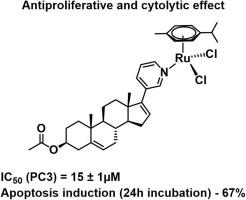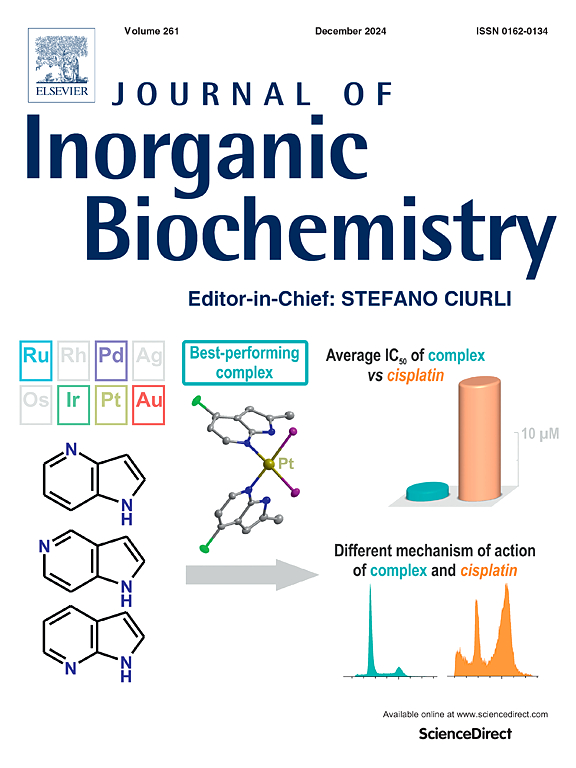Ruthenium complexes with abiraterone acetate as antiproliferative agents
IF 3.8
2区 化学
Q2 BIOCHEMISTRY & MOLECULAR BIOLOGY
引用次数: 0
Abstract
This study is dedicated to the development of multimodal anticancer agents. We have obtained ruthenium complexes conjugated with the steroid-type antitumor drug abiraterone acetate in order to take advantage of the dual antitumor properties of both ruthenium and abiraterone. The compounds exhibit good antiproliferative activity against cancer cells, with selectivity over primary fibroblasts. Real-time cell analysis revealed that compound dichlorido(η66-p-cymene)(abiraterone acetate)ruthenium(II) had pronounced antiproliferation activity compared to abiraterone acetate. Flow cytometric studies on the mechanism of cell death have revealed that the most active compound induces apoptosis more effectively than abiraterone acetate. Our findings demonstrate the potential of this novel dual-action compound as promising candidates for further development as anticancer agents.

与醋酸阿比特龙的钌配合物作为抗增殖剂。
这项研究致力于开发多模式抗癌剂。为了利用钌和阿比特龙的双重抗肿瘤特性,我们获得了与类固醇型抗肿瘤药物醋酸阿比特龙共轭的钌复合物。这些化合物对癌细胞具有良好的抗增殖活性,并对原代成纤维细胞具有选择性。实时细胞分析表明,与醋酸阿比特龙相比,二氯(η66-p-亚甲基)(醋酸阿比特龙)钌(II)化合物具有明显的抗增殖活性。关于细胞死亡机制的流式细胞仪研究显示,活性最强的化合物比醋酸阿比特龙更有效地诱导细胞凋亡。我们的研究结果表明,这种新型双效化合物具有作为抗癌药物进一步开发的潜力。
本文章由计算机程序翻译,如有差异,请以英文原文为准。
求助全文
约1分钟内获得全文
求助全文
来源期刊

Journal of Inorganic Biochemistry
生物-生化与分子生物学
CiteScore
7.00
自引率
10.30%
发文量
336
审稿时长
41 days
期刊介绍:
The Journal of Inorganic Biochemistry is an established international forum for research in all aspects of Biological Inorganic Chemistry. Original papers of a high scientific level are published in the form of Articles (full length papers), Short Communications, Focused Reviews and Bioinorganic Methods. Topics include: the chemistry, structure and function of metalloenzymes; the interaction of inorganic ions and molecules with proteins and nucleic acids; the synthesis and properties of coordination complexes of biological interest including both structural and functional model systems; the function of metal- containing systems in the regulation of gene expression; the role of metals in medicine; the application of spectroscopic methods to determine the structure of metallobiomolecules; the preparation and characterization of metal-based biomaterials; and related systems. The emphasis of the Journal is on the structure and mechanism of action of metallobiomolecules.
 求助内容:
求助内容: 应助结果提醒方式:
应助结果提醒方式:


